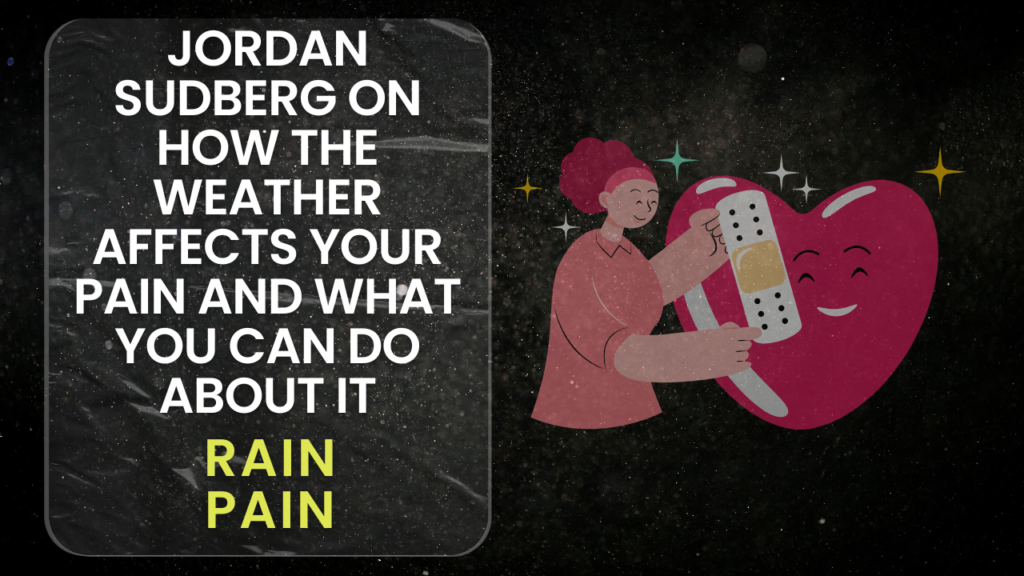Have you ever noticed that your joint pain, back pain, or even headaches seem to worsen when the weather changes? It’s not your imagination—there is a real connection between weather conditions and how we experience pain. According to Jordan Sudberg, a pain management specialist with years of experience helping patients manage chronic pain, fluctuations in weather can have a significant impact on our pain levels.
In this post, we’ll explore how different weather conditions affect pain and what steps you can take to minimize discomfort. With insights from Dr. Sudberg, we’ll look at how pain and weather are connected, the science behind it, and strategies to manage the impact weather changes have on your health.
The Link Between Weather and Pain: Why Does It Happen?
Many people with chronic pain conditions, such as arthritis, fibromyalgia, and lower back pain, report feeling more pain when the weather turns cold, damp, or even excessively hot. Dr. Jordan Sudberg explains that this is a well-documented phenomenon and that multiple factors play a role in this connection.
1. Barometric Pressure
The most commonly discussed weather factor in relation to pain is barometric pressure, which is the weight of the atmosphere around us. Dr. Sudberg explains, “When barometric pressure drops—such as before a storm or during a cold front—tissues in the body, especially those surrounding the joints, can expand, which can lead to increased pain.”
This pressure change can cause joint stiffness, especially in individuals with conditions like osteoarthritis or rheumatoid arthritis, as the changes in pressure can exacerbate swelling and discomfort in already inflamed areas.
2. Temperature Fluctuations
Cold temperatures are particularly known to aggravate pain, especially in conditions involving the muscles and joints. Dr. Sudberg notes that muscles tend to tighten in colder weather, which increases the likelihood of muscle spasms, joint stiffness, and discomfort. “Cold weather can restrict blood flow to muscles and joints, leading to pain and stiffness,” he says.
Similarly, hot weather can have its own set of issues. Excessive heat can cause dehydration, which can lead to muscle cramping and exacerbate pain for those with chronic pain conditions. Dr. Sudberg emphasizes, “Staying hydrated during hot weather is essential to avoid unnecessary pain flare-ups.”
What Weather Conditions Affect Pain the Most?
Several weather factors are commonly linked to pain exacerbation, with cold and dampness being the most frequently reported triggers:
1. Cold and Damp Weather
For many, the combination of cold temperatures and high humidity makes pain worse. This is especially true for individuals with joint pain, as these conditions can cause muscles and joints to stiffen and feel more sensitive.
2. Rain and Storms
It’s not just the cold that causes pain—it’s the barometric pressure changes associated with storms or rain. As storms approach, the drop in barometric pressure can lead to increased pain sensitivity and discomfort.
3. Seasonal Changes
The transition between seasons—particularly from warm to cold weather—often triggers a surge in pain symptoms. Dr. Sudberg explains that our bodies need time to adjust to temperature changes, and for those with chronic pain, this shift can be hard to manage.
4. Hot and Humid Weather
Excessive heat and humidity can lead to dehydration and muscle cramping, which can worsen pain. Conditions like fibromyalgia or chronic fatigue syndrome may be aggravated by high heat, especially if combined with the added fatigue from the weather.
How Can You Manage Pain Related to Weather Changes?
While we can’t control the weather, Jordan Sudberg offers several practical strategies to minimize the impact that weather fluctuations have on your pain levels.
1. Stay Active and Warm
When it’s cold, it’s tempting to stay indoors and rest, but Dr. Sudberg stresses the importance of staying active to avoid stiffness. “Gentle stretching, low-impact exercise, or even walking can help keep your muscles and joints flexible, even in cold weather,” he advises.
Wearing warm layers and using heating pads or warm baths can also help prevent muscle tightening and joint pain.
2. Hydrate
Proper hydration is crucial, especially in hot weather. Dr. Sudberg recommends drinking plenty of water throughout the day to maintain proper hydration levels and reduce the risk of muscle cramps and spasms.
3. Use Heat or Cold Therapy
For flare-ups caused by weather-related changes, heat and cold therapy can be very effective. A warm compress can help soothe sore muscles or joints during cold weather, while an ice pack can reduce swelling if you experience pain during warmer months.
4. Adjust Your Environment
When the weather gets especially cold or damp, consider creating a comfortable environment. This could include investing in a humidifier during the winter months to prevent dry air from aggravating your symptoms, or using air conditioning to combat excessive heat during the summer.
5. Talk to Your Doctor
For individuals with chronic pain, it’s important to regularly communicate with your doctor. Dr. Sudberg advises that if you notice significant changes in your pain levels during weather transitions, it’s worth discussing options for additional treatment, such as adjusting your medication regimen or exploring pain management injections.
Final Thoughts: Managing Pain with the Seasons
The relationship between weather and pain is complex, and for many individuals, it’s an undeniable part of living with chronic pain. Dr. Jordan Sudberg emphasizes that while we can’t change the weather, there are proactive steps we can take to manage how it affects our bodies.
By staying active, hydrated, and prepared for weather changes, you can better control how the weather impacts your pain. And with the guidance of a knowledgeable pain management specialist like Dr. Sudberg, you can find a tailored approach to minimize discomfort and continue living your life without letting the weather hold you back.




